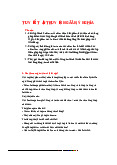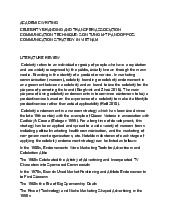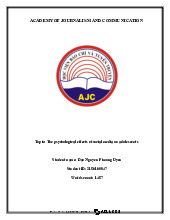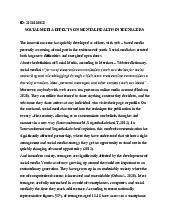




Preview text:
lOMoAR cPSD| 46560390 ( Words: 947)
What do you understand about mental health? To what extent the COVID - 19
pandemic had impacts on your mental health? Literature review
Mental Health - Definition
According to WHO 2004, mental health is a state of well-being in which each
one can cope with the normal stresses of life, work professionally and fruitfully,
and contribute to his or her community. Mental health conditions are
increasing worldwide. Mainly because of demographic changes, there has been
a 13% rise in mental health conditions and substance use disorders in the last
decade (to 2017). Mental health conditions now cause 1 in 5 years lived with
disability. Around 20% of the world’s children and adolescents have a mental
health condition, with suicide the second leading cause of death among 15-
29year-olds. Approximately one in five people in post-conflict settings have a
mental health condition. Since the Covid-19 pandemic appeared in late 2019,
these proportions tend to increase by impacts on our life, according to some studies by researchers.
Impact on children and adolescent ( 3-17 year old)
A realistic context that we are facing is an unprecedented global situation with
numerous idiosyncratic factors. As E. Esterwood, S.A. Saeed Past (2020) found
that people are being affected in multifaceted ways, having their physical,
psychological and emotional well-being compromised, along with social and
economic problems. The COVID-19 pandemic's variety and diversity of
biopsychosocial stressors necessitates a multifaceted strategy, which has
unanticipated repercussions for vulnerable groups such as children and
adolescents' mental health. Some research data such as Chen et al. (2020)’s
study has evaluated 1036 quarantined children and adolescents in China in an age
range from 6 up to 15 years, of which 112, 196, and 68 presented depression,
anxiety, and both, respectively. Another study of Saurabh and Ranjan (2020)
shows a significant proportion of psychological distress in children and lOMoAR cPSD| 46560390
adolescents isolated in India as a result of the COVID-19 epidemic. When
compared to non-quarantined youngsters, these people have experienced feelings
of helplessness (66.11 percent), concern (68.59 percent), and anxiety (61.98
percent). Moreover, it was also reported by Jiao et al. (2020) in China that children
and adolescents aged 3–18 years presented symptoms of inattention, clinging,
worry and irritability during this pandemic.
While COVID-19 is not as severe or death in children as it is in adults (Walker D,
Tolentino V (2020) found that the prevalence of COVID-19 in children is low
(between 0.8% and 3.3%) and that most children only have mild physical
symptoms or are asymptomatic), its impact on their health-related quality of
life (HRQoL) and mental health is not well understood. Dalton L et al. (2020)
also noted that children and adolescents face massive changes in their daily
lives, including school closures, home confinement, and social distancing rules,
which can burden them substantially. Exposure to mass media coverage of
crisis events and unverified information circulating on social media may
aggravate the mental distress. Furthermore, Thomas EY et al. (2020) found that
violence against children is reported to have increased under home
confinement leaving children at risk of abuse and trauma. Additionally, children
with a weak socioeconomic background and a history of mental illness may be
more vulnerable to cumulative risks. Impact on adult
The COVID-19 pandemic that has upended the lives of individuals worldwide
escalated in the U.S. beginning in March of 2020. And the early weeks of the
pandemic saw rapid changes in daily routines, with students moving following
university closures and attending classes remotely, and for other young adults,
transitioning to remote work or experiencing loss of work. COVID-19-related
worry (e.g., maintaining employment, getting tested for coronavirus) may be
linked to mental health symptoms for adults. So Conrad (2020) noted that
these disruptions may put an already vulnerable group at greater risk for
mental health challenges. According to World Health Organization (2020) with
new change measures such as self-isolation and quarantine have affected usual
activities, routines, and livelihoods of people that may lead to an increase in
loneliness, anxiety, depression, insomnia, harmful alcohol, and drug use, and lOMoAR cPSD| 46560390
self-harm or suicidal behavior. Furthermore , Rubin & Wessely (2020) noted
that fear of the unknown, the spread of the disease and the impact on people,
health, hospitals, and economies, for example, raises anxiety in healthy
individuals as well as those with pre-existing mental health conditions. And
Levin (2019) also found that individuals, families, and communities experience
feelings of hopelessness, despair, grief, bereavement, and a profound loss of purpose because of pandemics.
In this age of social media, the Coronavirus pandemic has an interesting feature
that individuals are being bombarded with rumors and disinformation that are
neither true or validated. With a rapid and near-constant stream of news
stories about an outbreak, such rumors and unauthenticated information
induce worry, anxiety, and stress. Impact on older adult
Because of a weak immune system, older adults experienced greater adverse
effects from the pandemic including more severe complications, higher
mortality. So Yaun Yang et al (2020) concluded that the outbreak of COVID-19
has raised great challenges for mental health services for older adults in the
community such as concerns about disruptions to their daily routines and
access to care, difficulty in adapting to technologies like telemedicine, and
concerns that isolation would exacerbate existing mental health conditions.
However, another research of Lee EE, Depp C, Palmer BW, et al (2019) found
that in comparison to younger individuals, older persons have reduced stress
reactivity and, in general, greater emotional control and well-being. And some
similar different studies such as in the Netherlands, a longitudinal study of
1679 community-dwelling older persons (65-102 years) by Van Tilburg TG
(2020) discovered that, while loneliness rose after the pandemic, mental health
levels were similar before and after the outbreak. References
1. F. Chen, D. Zheng, J. Liu, Y. Gong, Z. Guan, D. Lou lOMoAR cPSD| 46560390
Depression and anxiety among adolescents during COVID-19: a cross-sectional study
2. Brain Behav Immun, 88 (2020), pp. 36-38, 10.1016/j.bbi.2020.05.061 S0889-1591(20)30891- 6
3. W.Y. Jiao, L.N. Wang, J. Liu, S.F. Fang, F.Y. Jiao, M. Pettoello-Mantovani, E. Somekh
Behavioral and Emotional Disorders in Children during the COVID-19 Epidemic 264–266
(2020), 10.1016/j.jpeds.2020.03.013 4. K. Saurabh, S. Ranjan
Compliance and psychological impact of quarantine in children and adolescents due to Covid-19 pandemic
Indian J. Pediatr., 87 (7) (2020), pp. 532-536, 10.1007/s12098-020-03347-3
5. Walker D, Tolentino V (2020) COVID-19: the impact on pediatric emergency
care. Pediatr Emerg Med Pract 17:1–27
6. Thomas EY, Anurudran A, Robb K, Burke TF (2020) Spotlight on child abuse
and neglect response in the time of COVID-19. The Lancet Public Health
5(7):e371. https://doi.org/10.1016/S2468-2667(20)30143-2
7. Dalton L, Rapa E, Stein A (2020) Protecting the psychological health of
children through effective communication about COVID-19. Lancet Child
Adolesc Health. 2020 May; 4(5):346-347.
8. World Health Organization. (2020c). Mental health and COVID-19.
http://www.euro.who.int/en/health-topics/health-
emergencies/coronaviruscovid-19/novel-coronavirus-2019-ncov-technical-
guidance/coronavirusdisease-covid-19-outbreak-technical-guidance-
europe/mental-health-andcovid-19 lOMoAR cPSD| 46560390
9. van Tilburg TG, Steinmetz S, Stolte E, van der Roest H, de Vries DH.
Loneliness and mental health during the COVID-19 pandemic. Published online
August 5, 2020. J Gerontol B Psychol Sci Soc Sci. doi:10.1093/geronb/gbaa111
10. Lee EE, Depp C, Palmer BW, et al. High prevalence and adverse health
effects of loneliness in community-dwelling adults across the lifespan. Int
Psychogeriatr. 2019;31(10):1447-1462. doi:10.1017/S1041610218002120
11. Yuan Yang Wen Li Qinge Zhang Ling Zhang Teris Cheung Yu-Tao Xiang COVID
- 19 outbreak Published:February 18, 2020 DOI
:https://doi.org/10.1016/S2215-0366(20)30079-1 PlumX Metrics




